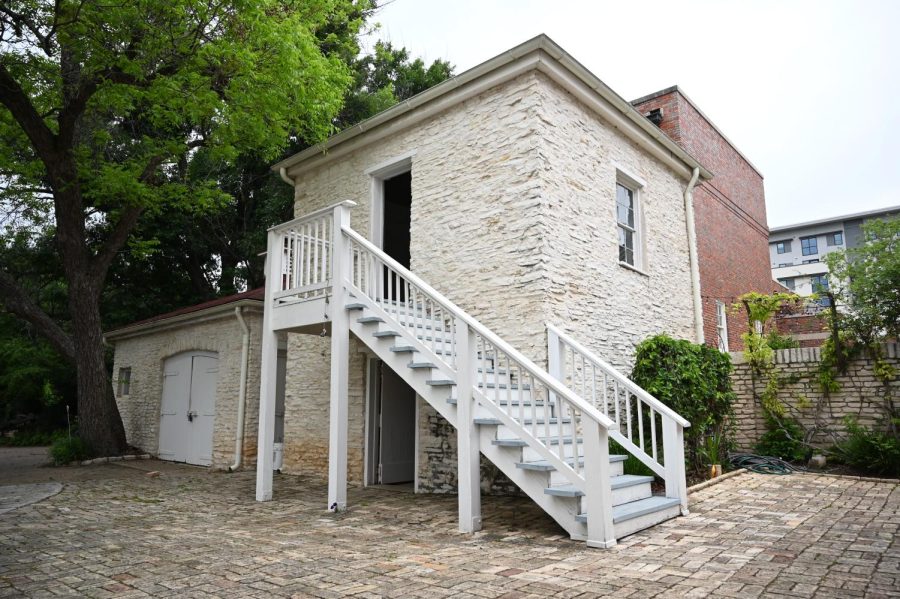Urban slave quarters rediscovered in West Campus
The last standing slave quarters in Austin sits behind the Neill-Cochran House Museum in West Campus. The two-story building originally had a living and lounge space for the enslaved people that worked within the main house on the top floor and a workspace on the bottom, with an internal opening and external staircase connecting the two.
May 8, 2022
Deep in the heart of West Campus sits the last standing slave quarters in Austin. Situated behind the Neill-Cochran House off San Gabriel and 24th Street, hundreds of UT students unknowingly walk the same ground every day as the quarter’s residents did during the Antebellum period.
“We’re a city that has intentionally obfuscated our early history,” said Rowena Houghton Dasch, executive director of the Neill-Cochran House. “Austinites don’t want Austin to have been a place of enslavement; that doesn’t fit well with our progressive ethos.”
The dwelling will now be renovated as a part of the museum’s “Reckoning with the Past: The Untold Story of Race in Austin,” a year-long program to reintroduce the public to the history of the quarters. The program involves an interpretive plan that contextualizes the building by restoring its interior design and includes new programming such as tours, exhibits and interpretive signage. A two-day event from April 23-24 kicked off the new project.
Dasch said she made the discovery of the quarters’ history in 2016 after she began examining how the house would have functioned if it had been constructed post-Civil War. This brought her attention to a dwelling behind the house, which was assumed to be a generic addition to the house, she said. When she realized the main house lacked space for housekeeping tasks like cooking and cleaning, Dasch said it quickly became clear that the two-story building in the back was originally used to house slaves.
Dasch said she asked Tara Dudley, a UT assistant professor in the School of Architecture, to work on a plan with the Neill-Cochran Museum House to make a more historically accurate exhibit. Dudley led students in her African American Experiences in Architecture course to examine the evolution of the building and its changes over time. During the process, Dudley recreated the interior and extended the museum’s programs to feature the stories of the enslaved peoples who lived there.
This research led to Lam, a 12-year-old boy hired from the Edgemont Plantation, now the current site of the military base Camp Mabry. When the Neill-Cochran House was used as the Texas State Asylum for the Blind in the 1850s, Lam taught the visually impaired students how to weave baskets, Dudley said, but did not receive any compensation for his work.
“Much of our history and knowledge about the past is lost because of the absence of buildings or just the ruins of them,” Dudley said. “One way to really get at understanding that built environment, whether it’s still present or not, is to repopulate those spaces.”
The quarters were built alongside the house, which was commissioned by Washington and Mary Hill in 1855, with the upstairs as a living space and the downstairs as a workspace. Despite being built with the same materials, the stones comprising the exterior of the quarters appear mismatched and hastily placed in comparison to the uniform exterior of the main home.
“There is no documentary evidence that that building is what we say it is,” Dasch said. “What we can say though, is it’s built (with) exactly the same materials as the (main) structure and is built in the same way as the structure. Once you understand its context, it makes no sense outside of enslavement.”
The dwelling does not look like the typical log cabin used for enslaved people on plantations, contributing to its misidentification, Dasch said. This distinction led Joe McGill, founder of the Slave Cabin Project, an organization dedicated to preserving and sharing the history of slavery, to change the foundation’s name to the The Slave Dwelling Project before he spent the night in the top floor of the slave quarters on April 23.
McGill led a talk the evening prior to the stay, giving people the opportunity to speak about current issues like reparations and removing monuments.
“We, as a city, have built over so much of that early history,” Dasch said. “You can imagine people accessing the site … and how they would have been working, and you just are never going to get that kind of visceral connection to history through a book.”



